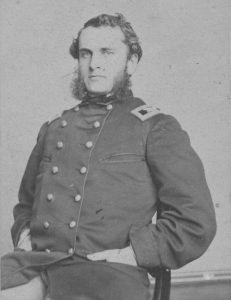Sykes, Chamberlain disagree on who sent Vincent up Little Round Top
The 20th Maine Infantry’s veterans read the air while positioned near Gettysburg on July 2, 1863.

Along with the other soldiers in Col. Strong Vincent’s 3rd Brigade, 1st Division (Brig. Gen. James Barnes), V Corps (Maj. Gen. George Sykes, effective June 28), the Maine boys had endured the rain- and scorching sunlight-plagued march north from Falmouth, Virginia before arriving at Gettysburg early on this Thursday.
The Mainers felt the heat, certainly unfamiliar at home, but typical in a sultry southern Pennsylvania summer that could resemble central Virginia’s, with a merciless sun leaving men perspiring badly, the sweat clinging to their skin.
Distant rumbling suddenly pricked men’s ears in midafternoon, and the air told veterans that a fight had started. Temporarily the 20th Maine’s major, Capt. Ellis Spear heard “the sound of increasing cannonade … all the time … the sound of battle in front developing more and more and sharper and clearer.”1
Summoned to Army of the Potomac headquarters on the Taneytown Road at 3 p. m., Sykes “and other corps commanders” conferred with Maj. Gen. George G. Meade.
During that meeting, “the enemy formed, opened the battle, and developed the attack on our left,” Sykes said. “I was at once ordered to throw my whole corps to that point [left flank] and hold it all hazards.”
Barnes started his division within an hour or so “rapidly up by the Taneytown road.” Spurring their horses, he and Sykes rode to reconnoiter “the ground assigned to the division.”2
Two wooded hills (the farther one taller) rose above the horizon. Artillery shells exploded in “white puffs … over the hill,” said Spear, not identifying which summit. Other shells flew high and landed near the Taneytown Road, one shell detonating in the V Corps’ column “just in front of us.”
The 20th Maine lads passed combat’s detritus, “stragglers and wounded coming to the rear,” he said.3
Sykes turned his column west toward the Wheatfield and Houck’s Ridge. His exact route from the Taneytown Road unclear to this day, Vincent and the 3rd Brigade crossed Plum Run.
According to Barnes, Brig. Gen. Gouverneur K. Warren (Meade’s chief engineer) “came up, riding rapidly from the left” and asked Sykes for troops to defend Little Round Top. His other two brigades — William S. Tilton’s 1st and Jacob B. Sweitzer’s 2nd — already moving to support III Corps, “Sykes yielded” to Warren’s “urgent request, and I immediately directed” Vincent to Little Round Top, said Barnes.
The 3rd Brigade “turned to the left, & rear and … marched around the north end of Little Round Top” and “occupied the crest,” Spear said..
Commanding the 44th New York Infantry, Col. James C. Rice reported the brigade “was detached from the division and ordered into position at about 4 p.m. … on the extreme left of our line of battle.”4
According to Col. Joshua L. Chamberlain, a Warren “staff officer” sought from Sykes “a brigade at least, to seize Little Round Top.” Intercepting the aide and “hearing this entreaty,” the “soldierly and self-reliant” Vincent assumed “the responsibility” and “ordered us to turn and push for Round Top.5
“We broke to the right and rear,” thumped across “a rude log bridge” spanning Plum Run, and took a farm road toward Little Round Top, Chamberlain recalled.
According to Oliver Wilcox Norton, the 83rd Pennsylvania soldier carrying the 3rd Brigade’s flag that day, Vincent saw “Sykes’s aide approaching” and “rode forward to meet him. I followed with the flag.”
Vincent pressed the aide for orders. “The captain answered, ‘General Sykes told me to direct General Barnes to send one of his brigades to occupy that hill yonder,’ pointing to Little Round Top,” Norton quoted the aide.
“I will take the responsibility of taking my brigade there,” Vincent responded. He deployed his regiments along Little Round Top’s southern and western slopes and placed the 20th Maine “on the extreme left of our entire line of battle,” Chamberlain said.
To his right flank (east) spread the 83rd Pennsylvania Infantry (Capt. Orpheus Saeger Woodward), Vincent’s former command. The 44th New York (Col. James C. Rice) deployed next to Woodward’s right and the 16th Michigan (Lt. Col. Norval E. Welch) next to Rice.
The 20th Maine occupied “a low wooded hill which sloped slightly in front and on the left, and our left wing extended down the hill,” said Spear. Neither his regiment nor the 3rd Brigade had long to wait.6
1 Abbott Spear, Andrea C. Hawkes, Marie H. McCosh, Craig L. Symonds, and Michael H. Alpert, ed., The Civil War Recollections of General Ellis Spear (Orono, ME, 1997), 32
2 Maj. Gen. George Sykes, Official Records. 27(1) 592; Brig. Gen. James Barnes, OR, 27(1) 600
3 Spear, Recollections, p. 33
4 Barnes, OR, 27(1), 600; Spear, Recollections, p. 33; Col. James C. Rice, OR, 27(1), 616
5 Gettysburg residents referred to Little Round Top by such names as High Knob or Sugar Loaf Hill. Chamberlain initially referred to “a rocky and wooded hill” in one July 6, 1863 report and elsewhere called the hill “Granite Spur.” He later referred to the hill as “Little Round Top” in the more detailed report he wrote years afterward for inclusion in the Official Records.
6 Joshua Lawrence Chamberlain, “Bayonet! Forward”: My Civil War Reminiscences (Gettysburg, PA, 1994), 21-22; Oliver Wilcox Norton, The Attack and Defense of Little Round Top, Gettysburg, July 2, 1863 (New York, NY, 1913), 263; The 20th Maine at Gettysburg, Portland Daily Press, Friday, July 24, 1863